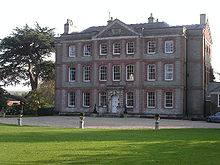
Ardington
Encyclopedia
Ardington is a village and civil parish about 2 miles (3 km) east of Wantage
in the Vale of White Horse
. Ardington was part of Berkshire
until the 1974 boundary changes
transferred it to Oxfordshire.
The parish includes the hamlet
of Ardington Wick
and stretches to the Great Western Main Line
between Didcot
and Swindon
.
Ardington is a downland village, with its parish stretching from the loam rich north to the chalk downlands to the south. The ancient path of the Ridgeway
runs through the southern part of the parish. There are several racing stables in and around the village, most of which use the Downs for gallops.
The oldest part of the Church of England parish church
of Holy Trinity
is the chancel
arch, built about 1200. The Gothic Revival architect
Joseph Clarke
added the tower and spire in 1856. Somers Clarke
remodelled the remainder of the church in 1887.
 Ardington House was built in 1721. It is a Georgian
Ardington House was built in 1721. It is a Georgian
Grade II* listed building and is open to the public in the summer months.
Wantage
Wantage is a market town and civil parish in the Vale of the White Horse, Oxfordshire, England. The town is on Letcombe Brook, about south-west of Abingdon and a similar distance west of Didcot....
in the Vale of White Horse
Vale of White Horse
The Vale of White Horse is a local government district of Oxfordshire in England. The main town is Abingdon, other places include Faringdon and Wantage. There are 68 parishes within the district...
. Ardington was part of Berkshire
Berkshire
Berkshire is a historic county in the South of England. It is also often referred to as the Royal County of Berkshire because of the presence of the royal residence of Windsor Castle in the county; this usage, which dates to the 19th century at least, was recognised by the Queen in 1957, and...
until the 1974 boundary changes
Local Government Act 1972
The Local Government Act 1972 is an Act of Parliament in the United Kingdom that reformed local government in England and Wales on 1 April 1974....
transferred it to Oxfordshire.
The parish includes the hamlet
Hamlet (place)
A hamlet is usually a rural settlement which is too small to be considered a village, though sometimes the word is used for a different sort of community. Historically, when a hamlet became large enough to justify building a church, it was then classified as a village...
of Ardington Wick
Ardington Wick
Ardington Wick is a hamlet in the Vale of White Horse, England. It was part of Berkshire until the 1974 local government boundary changes transferred it to Oxfordshire....
and stretches to the Great Western Main Line
Great Western Main Line
The Great Western Main Line is a main line railway in Great Britain that runs westwards from London Paddington station to the west of England and South Wales. The core Great Western Main Line runs from London Paddington to Temple Meads railway station in Bristol. A major branch of the Great...
between Didcot
Didcot
Didcot is a town and civil parish in Oxfordshire about south of Oxford. Until 1974 it was in Berkshire, but was transferred to Oxfordshire in that year, and from Wallingford Rural District to the district of South Oxfordshire...
and Swindon
Swindon
Swindon is a large town within the borough of Swindon and ceremonial county of Wiltshire, in South West England. It is midway between Bristol, west and Reading, east. London is east...
.
Ardington is a downland village, with its parish stretching from the loam rich north to the chalk downlands to the south. The ancient path of the Ridgeway
The Ridgeway
thumb|right|thumb|The ancient tree-lined path winds over the downs countrysideThe Ridgeway is a ridgeway or ancient trackway described as Britain's oldest road...
runs through the southern part of the parish. There are several racing stables in and around the village, most of which use the Downs for gallops.
The oldest part of the Church of England parish church
Church of England parish church
A parish church in the Church of England is the church which acts as the religious centre for the people within the smallest and most basic Church of England administrative region, known as a parish.-Parishes in England:...
of Holy Trinity
Trinity
The Christian doctrine of the Trinity defines God as three divine persons : the Father, the Son , and the Holy Spirit. The three persons are distinct yet coexist in unity, and are co-equal, co-eternal and consubstantial . Put another way, the three persons of the Trinity are of one being...
is the chancel
Chancel
In church architecture, the chancel is the space around the altar in the sanctuary at the liturgical east end of a traditional Christian church building...
arch, built about 1200. The Gothic Revival architect
Gothic Revival architecture
The Gothic Revival is an architectural movement that began in the 1740s in England...
Joseph Clarke
Joseph Clarke (architect)
Joseph Clarke, FRIBA was a British Gothic Revival architect who practised in London, England.-Career:In 1839 Clarke exhibited an antiquarian drawing with the Oxford Society for Promoting the Study of Gothic Architecture. Clarke was made an Associate of the Royal Institute of British Architects in...
added the tower and spire in 1856. Somers Clarke
Somers Clarke
George Somers Clarke was an architect and English Egyptologist who worked at a number of sites throughout Egypt, notably in El Kab, where he built a house. He was born in Brighton and died in Egypt....
remodelled the remainder of the church in 1887.

Georgian architecture
Georgian architecture is the name given in most English-speaking countries to the set of architectural styles current between 1720 and 1840. It is eponymous for the first four British monarchs of the House of Hanover—George I of Great Britain, George II of Great Britain, George III of the United...
Grade II* listed building and is open to the public in the summer months.

